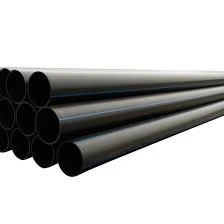Aug . 13, 2024 13:08 Back to list
Optimizing Drip Irrigation Systems with High-Density Polyethylene Pipe for Efficient Water Management Techniques
The Benefits of HDPE Pipe in Drip Irrigation Systems
In recent years, irrigation technology has significantly evolved, with sustainability and efficiency becoming paramount in agricultural practices. One major innovation in this field is the use of High-Density Polyethylene (HDPE) pipes in drip irrigation systems. HDPE pipes boast several advantageous properties that make them ideal for agricultural applications, particularly in environments where water conservation is essential.
Understanding HDPE Pipe
HDPE is a thermoplastic polymer made from petroleum, and its molecular structure allows it to be both lightweight and highly durable. The properties of HDPE make it resistant to many chemicals and environmental factors, including moisture, UV rays, and extreme temperatures. When used in agriculture, HDPE pipes provide a reliable solution for water delivery, ensuring that crops receive the necessary hydration without waste.
Water Efficiency and Conservation
One of the primary benefits of implementing HDPE pipe systems in drip irrigation is the improved water efficiency they offer. Drip irrigation delivers water directly to the plant roots, minimizing evaporation and runoff. This targeted approach allows for precise control over water application, ensuring that plants receive optimal hydration while conserving this precious resource. In regions where water scarcity is a concern, the adoption of HDPE pipes in drip irrigation can lead to significant water savings.
Durability and Longevity
The durability of HDPE contributes greatly to the overall effectiveness of drip irrigation systems. Unlike traditional piping materials, such as PVC or metal, HDPE is less prone to cracking, corrosion, and degradation over time. HDPE pipes have a long service life, often exceeding 50 years with proper installation and maintenance. This longevity not only reduces the frequency of pipe replacements but also lowers overall operational costs for farmers.
hdpe pipe drip irrigation

Flexibility and Ease of Installation
Another notable advantage of HDPE pipes is their flexibility. This flexibility allows for easy bending and shaping, accommodating diverse field layouts and terrain. Farmers can easily install these pipes without extensive modifications to the landscape, which makes them ideal for areas with variable topography. Moreover, HDPE pipes are lightweight, reducing transportation and installation costs compared to heavier alternatives.
Cost-Effectiveness
While the initial investment in an HDPE piping system may be higher than traditional materials, the long-term savings associated with their use are substantial. The durability, reduced maintenance requirements, and improved efficiency translate into lower operational costs for farmers over time. Additionally, the potential savings from water conservation can significantly impact a farm's profitability, especially in regions facing water shortages or rising utility costs.
Environmental Impact
By utilizing HDPE pipes in drip irrigation, farmers can adopt more sustainable agricultural practices. The efficient use of water not only helps in conserving this crucial resource but also minimizes the leaching of fertilizers and pesticides into the surrounding soil and waterways. This aspect of environmental protection is increasingly important in today’s climate-conscious world, making HDPE pipes a responsible choice for modern agriculture.
Conclusion
In conclusion, HDPE pipes are transforming the landscape of irrigation systems, particularly in the realm of drip irrigation. Their water-saving capabilities, durability, flexibility, cost-effectiveness, and positive environmental impact make them an excellent choice for farmers looking to improve efficiency and sustainability. As the agricultural sector continues to adapt to the challenges posed by climate change and resource scarcity, the adoption of advanced technologies like HDPE pipes is more critical than ever. For farms vying for productivity and sustainability, incorporating HDPE pipe systems into their irrigation practices is a step in the right direction.
-
High-Quality PPR Pipes and Fittings Durable ERA PPR & PVC PPR Solutions
NewsJul.08,2025
-
Black HDPE Cutting Board - Durable, Non-Porous & Food Safe HDPE Plastic Cutting Board
NewsJul.08,2025
-
High-Quality CPVC Panel Durable HDPE & PVC Panels Supplier
NewsJul.08,2025
-
Double PE Welding Rod Supplier - High Strength, Durable & Versatile Welding Solutions
NewsJul.07,2025
-
High-Quality PVC-O Pipe Supplier Durable 75mm PVC Pipe & Connections Leading PVC Pipe Company
NewsJul.07,2025
-
HDPE Drainage Pipe Supplier – Durable & Corrosion-Resistant Solutions
NewsJul.06,2025

